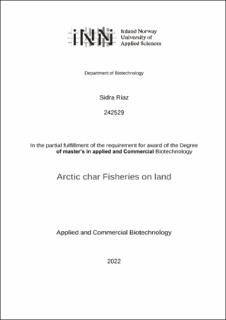| dc.description.abstract | The Aquaculture industry in Norway is the second largest industry and Norway is the largest exporter of salmon in the world. Thousands of salmon farms exists along the coastal and new technology land based salmon farming also started in Norway but farmers are producing only salmon smolts. Arctic char is another fish species that is harvested in Norway, but the char industry is still so young. Arctic char is cold-water fish that belongs to the Salmonidae family and can be anadromous or landlocked and can complete its life cycle in land-based systems. Arctic char farming is in practice in different parts of the world such as Iceland, Canada, Sweden, and Norway. Char Genetic improvement and breeding programs were conducted successfully in Iceland and Sweden. Iceland is the major producer of char in the world. Klosser innovasjon AS launched a char breeding program in 2015 in the inland county with the aim to develop sustainable land-based fish farming. Arctic char is selected by Klosser innovasjon AS as farm fish. Inland county is selected by investors as it is rich with natural resources (Freshwater, land, and breeding environment). At breeding, station-eyed roe is produced by breeders for sell to char farmers in the inland counties, and national and international markets. Inland county is the target market for the Klosser innovasjon AS. They are planning to establish a company for char breeding projects. Arctic Red AS will be a start-up future company that will be established by Klosser innovasjon AS with the goal to maintain the breeding project by producing eyed roes. The company will sell the roes to char farmers so that they will establish char farms in the inland counties. The aim of the thesis is to develop a successful business plan for the future company. Different methods such as value chain analysis, SWOT analysis, value proposition canvas, and business model canvas are used to develop a business plan. Value chain analysis gave a close overview of the activities that take part in developing the value for the target customers. SWOT analysis showed the company can grow in the future and fry can be a potential product in the future with eyed roes, but the company has very few potential customers which is a threat to the sustainability of the company. A successful business plan was developed for the Arctic Red AS with a yearly budget (roundabout 2 million with the production of 1,15 million-eyed roes). and future projection after analysis by using all the above-mentioned methods. The company can keep the project by delivering the right number of roes to target customers. The company will produce 2,5 million eyed roes within 2025 to meet the demand for national. As market analysis at national and international market showed the demand for Norwegian char in future. | |
